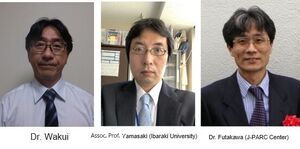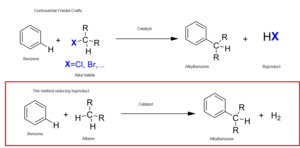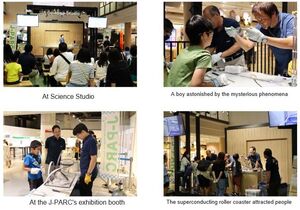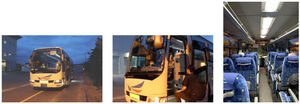J-PARC News September 2023 (Issue #221)
■Dr. Takashi Wakui of Neutron Source Section and His Collaborative Researchers Awarded Japanese Society for Experimental Mechanics 2023 Annual Meeting Award (Paper Award)
Dr. Wakui of the Neutron Source Section, Assoc. Prof. Yamasaki (Ibaraki University) and Dr. Futakawa (J-PARC Center) were awarded Japanese Society for Experimental Mechanics 2023 Annual Meeting Award (Paper Award) for the paper entitled “Effect of pulsed laser irradiation on the micro-plastic behavior of radiation shielding lead glasses”. The celebration ceremony was held in Wakayama prefecture on August 30th.
Irradiation damage is one of the factors that determine the lifetime of a mercury vessel, and then it is very important to quantitatively evaluate changes in material properties. Based on the results of the hardness test, a method has been devised to quantitatively evaluate material properties using inverse analysis including the finite element method. The effectiveness of this method has been confirmed when it was applied to the evaluation of ductile materials and ion-irradiated materials.
In this paper, they applied this method to radiation-shielding glass which is a brittle
material and local damage caused by high-intensity pulsed laser was quantitatively evaluated. In the future, they plan to apply this method to a mercury vessel to investigate radiation damage.
■Polarized Neutrons Observed Nanometer
-Thick Crystalline Ice Plates in Frozen Glucose Solution (August 22)
A group from JAEA, J-PARC Center, CROSS and Hiroshima University has successfully observed for the first time the peculiar shape of ice crystals immediately after their formation in a glucose solution using a technique called spin-contrast-variation (SCV) small-angle neutron scattering (SANS).
When food, pharmaceuticals or biological samples containing water are cryopreserved, the growth of nano-sized ice crystals in the water can destroy cellular tissue and degrade the quality of food or pharmaceuticals, or impair the function of biological tissue.
The research team sought to observe nanometer-sized ice crystals in sugar solutions using SCV-SANS, a technique developed over many years at J-PARC's Materials and Life Science Experimental Facility (MLF) BL15 "TAIKAN".
The analysis showed that the addition of glucose, a cryoprotectant, produced plate-shaped ice crystals with a thickness of 2-3 nm and an extension of more than tens of nm, and that the nuclei of ice crystals in glucose solutions hardly grew in a specific axial direction. This result suggests that glucose not only hydrates water molecules but also selectively binds to specific faces of ice crystals and suppresses the growth of these faces.
The research team intends to elucidate the mechanism of ice growth suppression by glucose molecules and other cryoprotectants in combination with computational science, and in the long run, they hope to contribute to the development of cryopreservation technology for organs, cells, eggs, and sperm, and to elucidate the life support functions of organisms in cold climates by sugar secretion through this method.
For more information, please visit the J-PARC website.
https://j-parc.jp/c/press-release/2023/08/22001192.html (Only in Japanese)
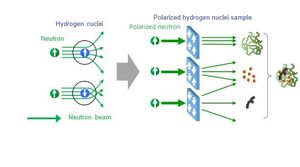 ■Pd Nanoparticles on the Outer Surface of Microporous Aluminosilicates for the Direct Alkylation of Benzenes using Alkanes (September 7)
■Pd Nanoparticles on the Outer Surface of Microporous Aluminosilicates for the Direct Alkylation of Benzenes using Alkanes (September 7)
A research group from Yokohama National University, Tokyo Institute of Technology, the University of Electro-Communications, and JAEA has developed a new catalyst that can directly bond alkanes and benzene. This catalyst consists of palladium nanoparticles supported on the outer surface of zeolite.
Alkylbenzenes are valuable industrial chemicals that are used in a variety of products, such as synthetic detergents. However, they are difficult to produce directly from alkanes. Conventional production methods generate a large amount of acid as a byproduct.
The new catalyst developed by the research group can be used to synthesize alkylbenzenes directly from alkanes and benzene. This process is more efficient and environmentally friendly than conventional methods.
The researchers used a technique called muon spin relaxation (μSR) in the D1 area of the Muon Experimental Facility at MLF of the J-PARC to study the reaction mechanism. They found that the catalyst activates the alkanes and benzene molecules, allowing them to bond together directly. The catalyst also helps to transfer hydrogen atoms between the molecules, which is essential for the reaction to proceed.
The research group believes that this new catalyst could be used to develop more efficient and environmentally friendly methods for producing a variety of valuable chemicals from alkanes.
For more information, please visit the J-PARC website.
https://j-parc.jp/c/press-release/2023/09/07001205.html (Only in Japanese)
■J-PARC Hello Science: "What is a 'Beam'?" (August 25)
As this month’s Hello Science, Dr. Katsuhiro Moriya from the Accelerator Division gave a lecture on the definition of "beam," one of the most commonly used words at J-PARC, as well as the fun and challenges of handling beams.
In general, the word "beam" is often used in the construction industry and in science fiction anime. The beam that is accelerated at J-PARC is a collection of protons flying in the same direction. The laser beam that is familiar from stage performances is similar to the image of the beam that is handled at J-PARC. In an experiment during the lecture, the principle of beam convergence was introduced by using the light from an LED light source as a beam.
The three accelerators at J-PARC use the forces of electric fields and magnetic fields to accelerate and converge beams. However, it was introduced that in the J-PARC, the world's highest-performance accelerators, many challenges are being faced in controlling beams, as the electromagnetic fields created by high-intensity beams can have a negative impact on the beams themselves, and the number of particles that make up the beams is too large to destroy beam monitors.
After the lecture, participants in the venue gave feedback such as "It was very easy to understand and I was interested." In response to the question "Why was J-PARC able to create high-intensity beams that are the pride of the world?" Moriya said with passion, "One of the factors that leads to good results is that at J-PARC, people from various fields work together smoothly across boundaries."
■Exhibited at the Magnet Power Exhibition (August 19 and 23, Hitachi Civic Center)
At the Magnet Power Exhibition at Hitachi Civic Center, J-PARC demonstrated a superconducting coaster with the cooperation of the Cryogenic Section, attracting a total of 272 visitors. Two science shows were held in the science studio on both days, and a workshop was held in the Orientation Room on August 19.
When a superconductor is cooled with liquid nitrogen, its electrical resistance becomes zero and a repulsive force called the Meissner effect is generated against a magnet. In this state, if a superconductor is forcibly pressed against a magnet, the superconductor will memorize the magnetic field lines of the magnet due to the pinning effect and an attractive force is also generated. In a superconducting coaster, the repulsive force and attractive force are balanced to allow a coaster made of a superconductor to float and glide on a track made of rubber magnets.
The audience was amazed by the superconductor that floated without falling and moved smoothly on the magnet, and they stared at it so as not to lose sight of it.
■Press Salon "In-depth Explanation of the Latest Results from the Muon g-2 Experiment" Held on August 18
The institute of Particle and Nuclear Studies (IPNS) in KEK held an online presssalon, which was attended by 27 members of the media from 14 companies.
Professor Tsutomu Mibe, the spokesperson of the J-PARC muon g-2/EDM experiment, and Associate Professor Akimasa Ishikawa, who is involved in the Belle II experiment, discussed the latest results of the muon g-2 (anomalous magnetic moment) experiment. They explained the overview of the muon g-2/EDM experiment being developed at J-PARC, the significance of verifying the g-2 experimental results through independent experiments, and the future prospects in collaboration with the Belle II experiment.
https://www2.kek.jp/ipns/ja/news/4937/ (Only in Japanese)
■J-PARC facility tour for "Muographic Investigation of Ancient Burial Mounds in Tokai" (August 27)
On August 27, a J-PARC facility tour was held with 47 participants. First, Director Kobayashi gave an overview of J-PARC. The participants were then divided into three groups to tour the linear accelerator, MLF, and Neutrino Experiment Facility sequentially. These facilities are not normally open to the public, and they seemed to be looking forward to this tour. In each facility, they had not only explanations from researchers but also opportunities to ask questions to the researchers. This was a precious experience for them.
※ This project is organized by the Tokai Village Board of Education, the J-PARC Center, Ibaraki University, and Tokyo Metropolitan University, which has been active since April this year.
■Sanpomichi㊳ -Business Shuttle Bus
A business shuttle bus runs between J-PARC's Tokai Campus and KEK's Tsukuba Campus, a distance of 80 kilometers each way. The bus makes five round trips a day, taking 1.5 hours for the trip. The passengers are a mix of staff who live near Tsukuba and work at J-PARC, and people who commute for experiments or meetings. People who are talking about work at the bus stop suddenly become silent and sit in different seats when they board the bus. They use the long ride to work on their computers, listen to music with headphones, or recline their seats to take a nap. The Joban Expressway from the Hitachi Minami-Ota Interchange to the Tsuchiura Kita Interchange is the section where some people get the most work done, and others sleep the best. The bus interior is filled with the sound of keyboards and gentle snores as it sways gently over the small bumps on the highway. At night, the headlights of trucks passing in the opposite lane often shine into the interior, but the passengers who are used to it don't mind. When the bus arrives at the stop, everyone wakes up, exchanges a brief greeting, and disperses to their respective destinations. The 1.5 hours spent on the business shuttle bus is a precious time for the passengers, a time when they can be alone and undisturbed.

